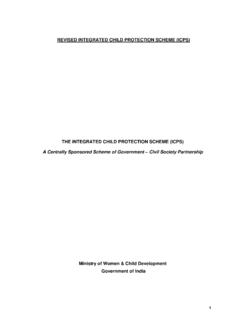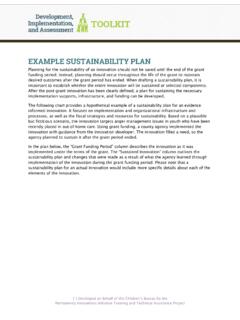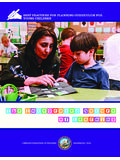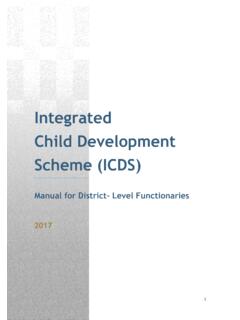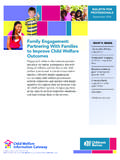Transcription of Transracial and Transcultural Adoption - Child Welfare
1 A FActSheet For FAmilieS 1994 Transracial and Transcultural Adoption Transracial or Transcultural Adoption means placing a Child who is of one race or ethnic group with adoptive parents of another race or ethnic group. In the United States these terms usually refer to the placement of children of color or children from another country with Caucasian adoptive parents. People choose to adopt transracially or transculturally for a variety of reasons. Fewer young Caucasian children are available for What s inside: How to prepare for the Adoption How to help your Child become a healthy adult Other sources of information Department of Health and Human Services Administration for Children and Families Administration on Children, Youth and Families Children s Bureau Child Welfare Information Gateway Children s Bureau/ACYF 1250 Maryland Avenue, SW Eighth Floor Washington, DC 20024 or Email: Transracial and Transcultural Adoption Adoption in the United States than in years past, and some Adoption agencies that place Caucasian children do not accept singles or applicants older than 40.
2 Some prospective adoptive parents feel connected to a particular race or culture because of their ancestry or through personal experiences such as travel or military service. Others simply like the idea of reaching out to children in need, no matter where they come from. Adoption experts have different opinions about this kind of Adoption . Some say that children available for Adoption should always be placed with a family with at least one parent of the same race or culture as the Child . This is so the Child can develop a strong racial or cultural identity. These people say that Adoption agencies with a strong commitment to working with families of color and that are flexible in their procedures are very successful in recruiting same race families. Other experts say that race should not be considered at all when selecting a family for a Child .
3 To them, a loving family that can meet the needs of a particular Child is all that matters. Still others suggest that after an agency works very hard to recruit a same-race family for a certain period of time but does not find one, the Child should be placed with a loving family of any race or culture who can meet the Child s needs. Despite the experts differing opinions, there are many Transracial and Transcultural families, and many more will be formed. If you are or wish to be a parent in one of these families, this factsheet will help you by answering two questions: (1) What should you do to prepare for adopting a Child of a race or culture different from yours? and ( ) After Adoption , what can you do to help your Child become a stable, happy, healthy individual, with a strong sense of cultural and racial identity? how to Prepare for the Adoption Preparation for Adoption is important for anyone thinking about adopting a Child .
4 It is even more important for parents considering Transracial or Transcultural Adoption because it will introduce you to all aspects of adoptive parenthood, help you learn about Adoption issues, and help you identify the type of Child you wish to parent. Any Adoption agency that conducts and supervises Transracial or Transcultural adoptions should provide this important service. If you are undertaking an independent Adoption , you should seek counseling and training in these areas. You should also read as many articles and books as you can on the subject. (See the resource list at the end of this factsheet.) The following sections describe some issues to consider as you prepare for a Transracial or Transcultural Adoption . examine Your Beliefs and Attitudes About race and ethnicity While you may think you know yourself and your family members very well, it is important to examine your beliefs and attitudes about race and ethnicity before adopting a Child of another race or culture.
5 Try to think if you have made any assumptions about people because This material may be freely reproduced and distributed. However, when doing so, please credit Child Welfare Information Gateway. Available online at Transracial and Transcultural Adoption of their race or ethnic group. There are two reasons for this exercise: (1) to check yourself to be sure this type of Adoption will be right for you; and ( ) to prepare to be considered different. When you adopt a Child of another race or culture, it is not only the Child who is different. Your family becomes a different family. Some people are comfortable with difference. To them, difference is interesting, wonderful, and special. Other people are not so comfortable with difference, and are scared by it. Thus, some friends, family members, acquaintances, and even strangers will rush to your side to support you, while others may make negative comments and stare.
6 During the pre- Adoption phase, you should think about how you will respond to the second group in a way that will help your Child feel good about himself or herself. (We ll give you some ideas a little later.) When your Child is young, an extra hug and a heart-to-heart talk might be all it takes to help him or her through a difficult situation. While the hugs and the heart-to-heart talks never stop, as your Child gets older, you and your Child will need more specific coping skills to deal with the racial bias you might face together as a family. Are you ready to fully understand these issues and help your family deal with whatever happens? think About Your lifestyle Before considering a Transracial or Transcultural Adoption , take a look at your current lifestyle. Do you already live in an integrated neighborhood, so that your Child will be able to attend an integrated school?
7 If not, would you consider moving to a new neighborhood? Do you already have friends of different races and ethnic groups? Do you visit one another s homes regularly? Do you attend multicultural festivals? Do you enjoy different kinds of ethnic foods? How much of a leap would it be to start doing some of these things? It is important for children of color growing up with Caucasian parents to be around adults and children of many ethnic groups, and particularly, to see adult role models who are of the same race or ethnic group. These people can be their friends, teach them about their ethnic heritage, and as they mature, tell them what to expect when they are an adult in your community. Can you make these types of relationships available for your Child ? consider Adopting Siblings It is always good for siblings to be adopted together. It is no different in the case of Transracial or Transcultural Adoption .
8 Siblings who are adopted together have the security of seeing another person in the family who looks like them. They are able to bring a part of their early history and birth family with them to their adoptive family, which may help them adjust better. And with internationally adopted children, being together might mean they will be able to keep up their native language. how to help Your Child Become a healthy Adult Let s say, then, that you have examined your beliefs and attitudes about race and ethnicity. You have thought about your This material may be freely reproduced and distributed. However, when doing so, please credit Child Welfare Information Gateway. Available online at Transracial and Transcultural Adoption lifestyle and considered adopting siblings. You are sure you want to adopt a Child from another race or culture.
9 What comes next? The seven parenting techniques listed below were compiled from books and articles on Adoption and by interviewing experts in Transracial and Transcultural Adoption . Some of these techniques are common sense and apply to all adopted children. However, with transracially or transculturally adopted children, these techniques are especially important. Parents in a Transracial or Transcultural family should do the following: Become intensely invested in parenting Tolerate no racially or ethnically biased remarks Surround yourselves with supportive family and friends Celebrate all cultures Talk about race and culture Expose your Child to a variety of experiences so that he or she develops physical and intellectual skills that build self-esteem Take your Child to places where most of the people present are from his or her race or ethnic group The next sections provide more information on these techniques.
10 Become intensely invested in Parenting Dr. Larry Schreiber, former president of the North American Council on Adoptable Children (NACAC), an umbrella organization for a large number of adoptive parent support groups in the United States and Canada, wrote a column about his Transracial Adoption experience in the Winter 1991 issue of Adoptalk,1 the NACAC newsletter. He characterizes Transracial parenting as a roller coaster of exaggerated parenting. As a Caucasian adoptive father of African-American, Latino, Korean, Cambodian, East Indian, and Caucasian children, he describes Transracial parenting as the most joyous experience of his life. He admits that he doesn t really know what it is like to endure the racially-biased name-calling that his children have experienced, but he was always there for them when they needed to be comforted and to help them get through those difficult times.










